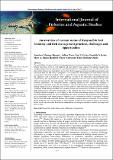An overview of current status of Kenyan fish feed industry and feed management practices, challenges and opportunities
Publication Date
2014Author
Jonathan Mbonge Munguti, Safina Musa, Paul S. Orina, Domitila N Kyule, Mary A. Opiyo, Harrison Charo-Karisa and Erick Ochieng Ogello
Metadata
Show full item recordAbstract/
The profitability of commercial fish farming operation is of paramount importance to all farmers. However,
farmers must have access to well-balanced and cost effective feeds coupled with optimal on-farm feed
management practices as a prerequisite to profitable production. This paper presents an audit of the current
status of the Kenyan fish feed industry and on-farm feed management practices including opportunities and
constraints from the fish farmer’s perspective. The Kenyan fish feed industry has been boosted with the
development of fish feed standards, which is expected to ensure quality fish feeds for all farmers. Much of
the aquafeeds used in Kenya are either produced on-farm or by small-scale semi-commercial feed
manufacturers, and improvements to the quality and preparation of these feeds are likely to bring about
improved productivity and cost savings. Since feed management practices significantly impacts the
economic performance of production systems, adopting appropriate feed management strategies is
instrumental to maximize returns. In a few instances, innovative farmers have reported developing their own
feeding strategies such as spreading feeds at fixed points at same time daily, bag and restrictive feeding
techniques, break feeding schedules and promoting natural pond productivity. Provision of species-specific
feeds addressing the nutritional requirements of the different life stages of fish is still an issue. Other
challenges include inadequate access to finance, a lack of technical innovations, absence of feed formulation
and processing knowledge and poor feed handling and storage techniques. The potential to develop publicprivate partnerships with farmer groups to improve access to information should be considered. Programs
that use the local media to provide farmers with extension messages must be encouraged. The government
should frequently carry out spot checks on feeds supplied to Agrovets to ascertain its quality. Fish farmers
should also be trained on feed formulation, transportation and storage to maintain a constant feed supply and
save on costs.

